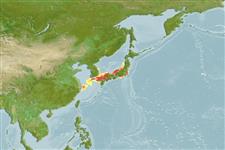Environment: milieu / climate zone / depth range / distribution range
Écologie
marin démersal. Temperate
Northwest Pacific: Japan Sea off coast of northern Honshu, Japan.
Taille / Poids / Âge
Maturity: Lm ? range ? - ? cm
Description synthétique
Clés d'identification | Morphologie | Morphométrie
Épines dorsales (Total) : 11 - 13; Rayons mous dorsaux (Total) : 9 - 10; Épines anales: 0; Rayons mous anaux: 17 - 20. Closely resembles O. iburia in general appearance, but differs by having a few enlarged subpectoral plates, and 35 or fewer dorsolateral and ventrolateral plates.
Life cycle and mating behavior
Maturities | Reproduction | Spawnings | Egg(s) | Fecundities | Larves
Masuda, H., K. Amaoka, C. Araga, T. Uyeno and T. Yoshino, 1984. The fishes of the Japanese Archipelago. Vol. 1. Tokai University Press, Tokyo, Japan. 437 p. (text). (Ref. 559)
Statut dans la liste rouge de l'IUCN (Ref. 130435)
Menace pour l'homme
Harmless
Utilisations par l'homme
Outils
Articles particuliers
Télécharger en XML
Sources Internet
Estimates based on models
Phylogenetic diversity index (Ref.
82804): PD
50 = 0.5625 [Uniqueness, from 0.5 = low to 2.0 = high].
Bayesian length-weight: a=0.00389 (0.00180 - 0.00842), b=3.12 (2.94 - 3.30), in cm total length, based on all LWR estimates for this body shape (Ref.
93245).
Niveau trophique (Ref.
69278): 3.2 ±0.3 se; based on size and trophs of closest relatives
Résilience (Ref.
120179): Milieu, temps minimum de doublement de population : 1,4 à 4,4 années (Preliminary K or Fecundity.).
Fishing Vulnerability (Ref.
59153): Low vulnerability (16 of 100).
